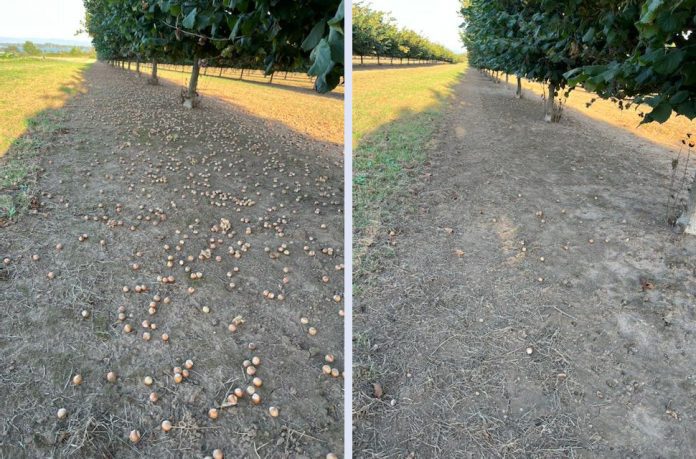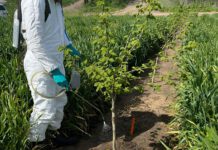
Research into use of a plant growth regulator to hasten nut drop in hazelnuts is showing promise, according to Oregon State University Extension Orchard Crops Specialist Nik Wiman, who provided data on the project at the Oregon Hazelnut Summer Tour, Aug. 3 in Albany, Ore.
In the Jefferson variety, researchers were able to advance nut drop by about two weeks in 2019, Wiman said. They recorded even more encouraging results in Yamhill, advancing nut drop by up to three weeks in one experiment. Researchers also were able to condense nut drop in Yamhill, which typically has an extended nut drop period, often requiring multiple picks.
“The nuts were falling over a shorter period of time compared to the control,” Wiman said.
“I think Ethephon is a potentially useful tool to accelerate nut drop in hazelnuts,” he said.
Hazelnut growers began funding research into hastening nut drop of high-yielding, late-maturing varieties after a rainy fall six years ago created problems at harvest and lowered some yields.
“The winter meeting that year was all about how messy that harvest year was because of the fall rains that came early,” Wiman said. “And we were starting to see some heavy crop in some of the new varieties; it was a total mess.”
Growers were forced to leave large volumes of hazelnuts on the ground as well, especially those from the late-maturing variety Jefferson. “Even last year was pretty messy,” Wiman said. “I know my program was forced to leave quite a few nuts on the ground, and that is pretty painful to see all those nuts laying there and you can’t get them.”
As luck would have it, former OSU horticulture faculty researcher Harry Lagerstedt was in the audience during the winter meeting of 2016, and he approached Wiman with some work he had done in the 1970s with Ethephon.
“He referred me to some of his pioneering research in the 1970s on Ethephon use in filberts,” Wiman said. “At the time, they were trying to accelerate nut drop in [the variety] Barcelona. I took those papers and we started to work with this material.”
Promotes Ethylene
Ethephon, a synthetic plant growth regulator, works by promoting the ripening agent ethylene in plants. The product works on abscission layers, Wiman said, by promoting the expression of certain genes that promote the separation of plant parts. The product is widely used in walnut production.
At some point, the hazelnut industry lost its Ethephon label, Wiman said. “It just kind of fell off because of lack of use.” But Wiman was able to secure a 24C special local needs label for the hazelnut industry in 2020, a label that has been extended to 2026.
Wiman said he was thankful for the work Lagerstedt had done and utilized it as a starting point for determining not only rates but timing.
“We took that straight out of Harry’s playbook, where he recommends that if you are rolling nut clusters in your hand and you can easily detach nuts from the husk, then the abscission layer is starting to form, the nuts are largely mature and they don’t need to be attached to the tree anymore,” Wiman said. “Also, they say in that old spray guide that it is usually around the third week of August.”
As a point of caution, Wiman advised growers to avoid applying the product too late. And don’t apply the product to trees that are stressed.
“Our first year, we applied it too late, and we ended up with a mass of leaves in our harvest,” Wiman said. Stressed trees already are dropping leaves early, he said, so it is important not to accelerate that with Ethephon.
Wiman also found excess leaf drop in the Yamhill variety when applying Ethephon at the top end of allowable rates. “With Yamhill, we did see a significant increase in leaf drop in the highest concentration we tested, and successive years showed similar data,” Wiman said. But, he said, when applied at the proper timing and at the mid- to lower-range of allowable rates, Ethephon did not significantly increase leaf drop.
“The risk is in waiting too long and causing too much leaf drop. If you want to try it, you want to get on the application as soon as you can roll the nuts out of the husk pretty easily,” Wiman said.
Quality Effects
Researchers have analyzed several issues surrounding use of Ethephon in experiments over the past four years, Wiman said, including how nuts responded to different rates, whether Ethephon-treated nuts required more dry-down time and whether nuts treated with Ethephon were finished ripening.
“The thing that I was worried about was if we are getting nuts to drop early, are they really finished and are there any quality effects on the nuts themselves,” he said.
Wiman found that nuts that dropped early after being treated with Ethephon were indeed finished. And he discovered the nuts required about the same dry-down time as untreated nuts.
“We didn’t see much of a moisture effect with the nuts that were coming down earlier because of these treatments,” he said. “These nuts were really not any different than the nuts that were falling naturally without any Ethephon applied in our untreated controls.
“However, when we looked at crack-out… I think there is some effect here with a slight decrease in the percentage of nuts that are kernels,” Wiman said. “As the rate of Ethephon is increased, there is a slight decrease in percentage of kernels.
“That is an important thing to know,” he said. “If you are looking to do some trials with this product, this is one thing that I would keep track of, to see this effect, because this could be a tradeoff that maybe makes this not worth it. But it is a pretty small effect.”
He added that “there really is no difference in the percentage of good nuts. So, we are not seeing any defect on kernels that are treated with Ethephon.”
Rates, Coverage Critical
Wiman said it is important for growers to pay attention to dose rates. “The rate is critical, and the response can be very dose dependent,” he said. “On the label, we put 750 to 1000 parts per million, but, for example, on Jefferson, you might be able to get away with a lower rate and still see a good effect.”
Coverage also is critical, he said. “You don’t want to be applying at a low rate because you are trying to get coverage on the husk of the nut clusters. So, that is why the label specifies a high rate of water. You really want to see 90 to 100 gallons per acre with these applications to get really good coverage of the husk.”
One drawback to the existing label is that it carries a 28-day preharvest interval (PHI), but Wiman said he hopes that will change in the near future. “There is potentially a flaw in some of the residue data used to construct the PHI,” he said, “considering that with walnuts, they can treat within five days of harvest with this product.”
Wiman said the industry has asked the IR-4 program to conduct the necessary research to get the PHI reduced. Oregon State University IR-4 Specialty Crops Pesticide Registration Leader Dani Lightle confirmed with West Coast Nut that she is working on the issue.















